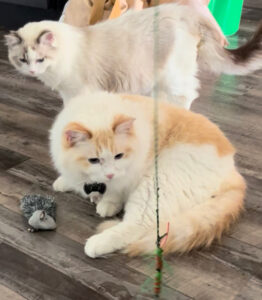
When adding a new cat or kitten to your family, it’s important to start things off on the right foot (or should I say paw) from the beginning. Cats who weren’t introduced properly can sometimes have a lifetime of inter-cat aggression issues that are very hard to retrain. Especially since cats don’t like changes in their environment, following some simple first steps will make for an easier transition.
For any new cat introduction, I recommend the use of Feliway. There are different types and noted below as to which I recommend for different situations. This is a synthetic cat pheromone that has been shown to reduce stress in cats that respond to it. It is available as a spray or diffuser from most pet retailers. I have personally had success with it in various stress-related behavior situations. The worst that I’ve seen is no response at all, so it could be worth trying. Please note the diffuser needs to be refilled when no more liquid is visible. The manufacturer says that’s 30 days, but my experience has been closer to 20-25 days. I recommend continuing until several weeks after your new cat has adjusted.
Single Cat
Even if this is the only pet in the house, a new cat should start in one closed room. All their required resources should be in there with them including a litter box, food and water, toys, cat bed (somewhere comfortable to sleep) and a scratcher. Plugging in a Feliway Classic variety diffuser in their room can help them adjust by reducing stress – click here. Especially if your new family member had previously been in a cage, the new large space is very overwhelming. If possible, it’s great to have a toy or towel that was with them before their arrival with their scent on it. Ask the animal shelter or breeder your cat is coming from if you can have something like that for a less stressful transition.
After approximately a week you can begin to expand the space slowly and watch their reaction. Start to open the door and see what they do. Some cats will be happy to come out and are ready to explore. Others may still be reluctant. There’s no good or bad response. Every cat will have a different adjustment period. If they seem hesitant, more time in the room may be needed depending on the size of your home.

Multi-Cat
Introducing your new family member to existing cats in the home should begin the same way. The new cat should be kept in a room, with all their needed items. The primary sense for cats is smell and this is how their meeting will begin. A Feliway Multi-Cat option would be used in this case and plugged where the cats will be first coming near each other – such as the hallway outside where the new cat is staying. CLICK HERE.
As your new cats adjusts to the new smells and surroundings in their room, your current cat will likely be smelling under and around the door. This is how they’re starting to meet each other. They may each put paws under the door which is fine. This should be done for at least a week. While the door remains closed, you can start building the group scent that will show they will be one family. Using the same brush and leaving a bit of fur, brush each cat with it. Gently rub a washcloth around the cheeks of one cat (ideally with a clean washcloth using unscented detergent) and leave it for the other cat to smell in an area they sleep or rest. You can combine the fur of both cats by creating a fur “log” by rolling it together with your fingers. Give one to each cat as a toy. Cats have been known to enjoy these and it continues to reinforce that new group scent with a positive experience like play.
You can start to serve their meals at the same time on either side of the closed door. They will know the other one is there by scent and will again be learning that something good like their food is happening when they are together. If food was always available throughout the day, you may want to restrict it to twice daily meal times just for the introduction period.
After a week, the door can be opened an inch or so and allow for their first nose to nose interactions. Place something heavy to keep the door from opening further or a partially covered baby gate can also be used. As each cat smells the other, treats can be given to both (or more) at the same time. Their first face to face meetings should be associated with more good things. Continue to serve meals together on either side of the partially opened door or baby gate.
Ideally at this point, there is no extreme aggression being demonstrated. A little hissing or growling is normal and can be expected until territory is established and everyone learns their place. If this is the case, you can begin to allow more contact with supervision. Bring out some new toys, especially interactive wand type toys, and play with both (or all) cats. Your new cat will likely continue to use the room as a safe home base for a little while to come. It now has their scent and has become familiar. You can leave some of their things in that room until you notice they are getting comfortable and finding new places to relax around your home.
Continue to reinforce good things happening when they are together including petting, play, feeding, brushing and treats. Try to pet both at the same time with extended arms when they are close enough together.

Longer Adjustment
If you’ve followed these steps, but one of the cats is acting aggressively, or possibly even fighting, your new cat needs to remain isolated and a longer adjustment period is needed. All cats are different and adjust differently. Continue to reinforce good interactions around a partially closed door or gate with treats and play time. The group scent is very important and continue to refresh the cheek scents daily on the washcloths you are swapping in their space.
Additionally, you can allow them to switch space for slowly increased periods of time. For an hour or so at first, allow your new cat to come out and instead enclose your original cat/cats in the closed room. This will be a huge scent exchange. The remainder of the house will begin to pick up the scent of the new cat and the existing household cats will get a very good smell of the new cat. Gradually increase the time that the space is exchanged for each until you reach an overnight period. Be sure everyone has the needed resources where they being kept including litterbox, water, food, scratcher, comfy place to sleep and toys.
After about two weeks of the space swapping, attempt again to open a door or baby gate enough to allow for nose to nose interactions. Reinforce any positive behavior (no growling, hissing or fighting) with lots of treats for everyone while they are together. Repeat the process for longer if needed. They may never become the best of friends that sleep together all day, but most cats can learn to at least tolerate each other and co-exist.
Please note that I only recommend products that I use myself and feel can be helpful in working to solve various behavior issues. As an Amazon Associate, I do earn from qualifying purchases. There is no additional cost to you in any way.


